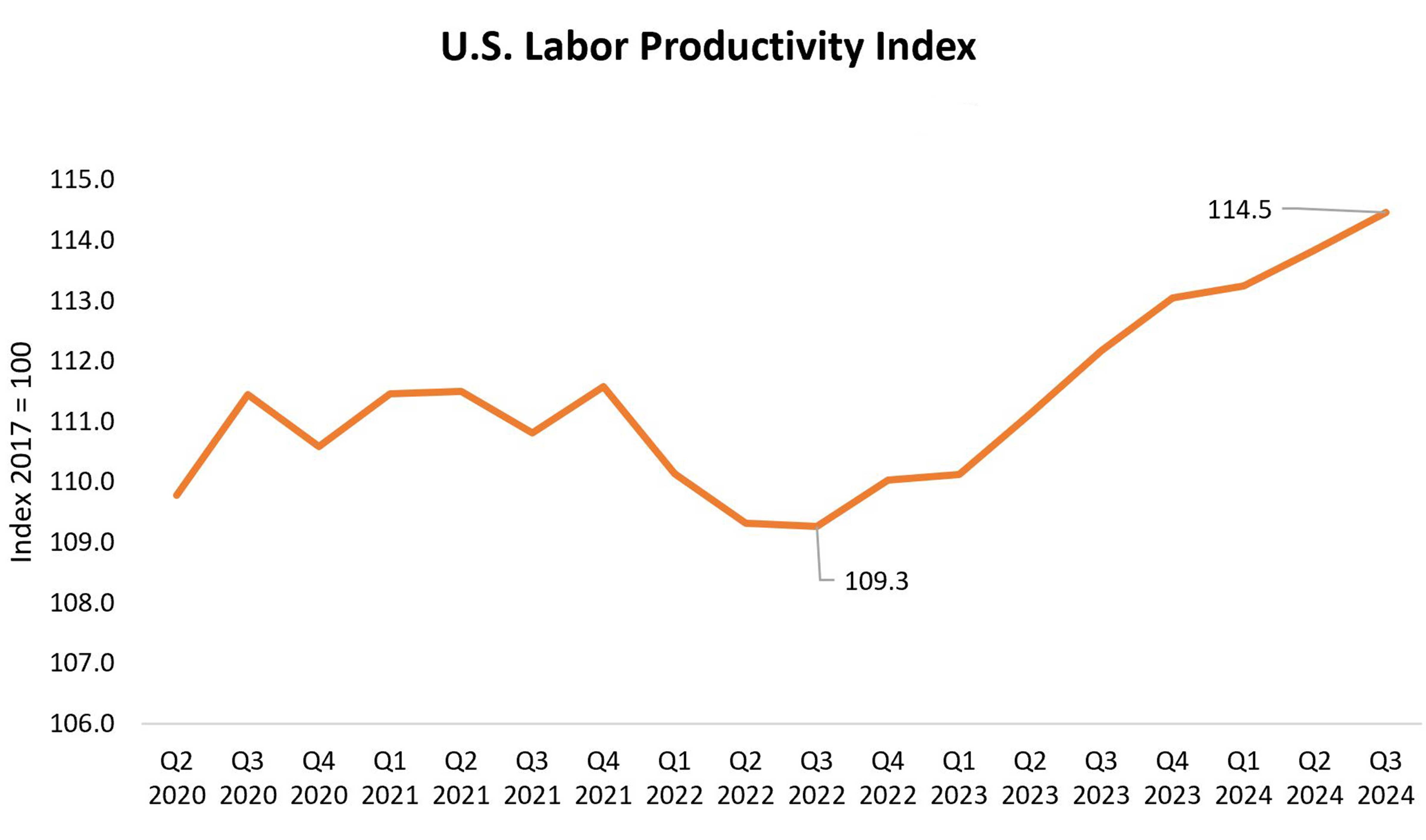US large-cap equities: Focus shifts to earnings delivery
Portfolio Manager Jeremiah Buckley shares his 2025 outlook for U.S. large-cap equities, highlighting positive earnings trends and economic strength. He also discusses why the market may increasingly differentiate between companies delivering on growth expectations and those falling short and explains why companies investing in innovation and growing market share are positioned to stand out.

5 minute read
Key takeaways:
- The outlook for U.S. large-cap equities remains positive, supported by continued earnings growth, strong consumer spending, and healthy labor markets. However, the S&P 500® Index’s 2024 gains have outpaced earnings growth, leading to higher valuations.
- Rising valuations suggest the market will increasingly differentiate between companies delivering on earnings expectations and those falling short. Selectivity is particularly important across sectors, and within subsectors, where stock prices have risen without corresponding earnings growth.
- In our view, companies investing in innovation and gaining market share can drive sustained incremental earnings growth. These firms may be better positioned if economic growth falls short of optimistic forecasts, compared with competitors that depend more heavily on broad economic expansion.
Strong earnings and resilient economic growth fueled U.S. equity market gains in 2024. While technology and communication services stocks led both earnings and performance gains, market leadership broadened as cyclical sectors like financials and industrials gained momentum.
The outlook for U.S. large-cap equities remains positive, supported by ongoing earnings growth and economic strength. However, it’s important to note that the S&P 500’s 2024 rise has outpaced earnings growth. This makes selectivity important across sectors, and within subsectors, where valuations have expanded. In our view, a company’s ability to deliver growth that justifies its valuation may be a key determinate of performance in 2025.
A supportive economic backdrop
The U.S. economy is on solid footing, with moderate growth supported by a strong consumer and healthy labor markets. Rising disposable personal income, stock market gains, higher interest on cash, and real wage growth point to healthy consumer spending ahead. Corporate profit margins have held up, suggesting limited likelihood of mass layoffs. Furthermore, the Federal Reserve (Fed) can deploy stimulative policies if needed, supporting expectations of a soft landing.
A particularly encouraging development is the recent resurgence in labor productivity (Figure 1). This often-overlooked economic driver enables companies to increase wages while maintaining profit margins. In turn, this wage growth supports robust consumer spending, a crucial engine for the economy. We believe this uptick in productivity is set to continue due to the innovations and artificial intelligence (AI) productivity gains we are witnessing across sectors.
Figure 1: Labor productivity rebound
Since the third quarter of 2022, the U.S. Labor Productivity index has climbed for eight consecutive quarters following three quarterly declines.
 Source: U.S. Bureau of Labor Statistics, Nonfarm Business Sector: Labor Productivity (Output per Hour) for All Workers. Index 2017 = 100, quarterly frequency, seasonally adjusted. Data as at 7 November 2024.
Source: U.S. Bureau of Labor Statistics, Nonfarm Business Sector: Labor Productivity (Output per Hour) for All Workers. Index 2017 = 100, quarterly frequency, seasonally adjusted. Data as at 7 November 2024.
In terms of economic risks, we are monitoring the concentrated nature of recent job gains in specific sectors like hospitality, healthcare, government, and construction, as overall job growth could be constrained by limited participation.
Tech and other growth opportunities
Looking at specific opportunities, AI remains a compelling theme despite recent volatility in related stocks. Fundamental signals are strengthening, with increased capital spending and robust demand for graphics processing units (GPUs) and AI-related infrastructure. We maintain a positive view on hyperscalers and semiconductor infrastructure stocks, whose valuations appear reasonable given their growth trajectories and logical capital spending plans.
Outside of technology, we believe healthcare stocks present attractive growth prospects and reasonable valuations, particularly in the biotech and medical device subsectors, where scientific breakthroughs are enabling several new treatments.
Additionally, we see compelling opportunities in consumer services and financial services. The strong labor market bodes well for consumer discretionary spending, particularly in travel and hospitality. In financials, we’re positive on the continued shift from cash to card-based payments as well as financial services companies that stand to benefit from increased capital markets activity.
Utilities, with improving growth prospects and attractive dividend levels, are another area of interest. Accelerating data center electricity demand and the electrification trend more broadly are driving higher long-term earnings growth guidance for the sector.
Focus on innovative, market share-gaining companies
While we maintain a positive outlook on U.S. large-cap equities, selectivity is key. In 2025, we expect the market to increasingly differentiate between companies delivering on earnings expectations and those falling short. Some sectors that rallied on interest rate declines or election optimism, particularly banks and capital goods companies, have seen multiple expansion without corresponding earnings upgrades, making their valuations vulnerable.
Also, market prices in some sectors reflect expectations of accelerated economic growth under the new administration’s pro-growth policies. However, we believe a more likely scenario is consistent economic activity that supports a soft landing. Therefore, we are focused on where multiple expansion is warranted by fundamental strength versus where it merely reflects temporary optimism.
In our view, companies investing in innovation and gaining market share will stand out from competitors. These firms’ ability to generate internal growth provides a buffer against valuation pressure if the economy doesn’t accelerate, unlike competitors who tend to rely more heavily on broader economic conditions to drive earnings growth. We believe high-quality growth firms with differentiated products can drive sustained earnings growth across various economic scenarios in 2025 and beyond.
S&P 500® Index reflects U.S. large-cap equity performance and represents broad U.S. equity market performance.
Volatility measures risk using the dispersion of returns for a given investment.
IMPORTANT INFORMATION
Equity securities are subject to risks including market risk. Returns will fluctuate in response to issuer, political and economic developments.
Growth stocks are subject to increased risk of loss and price volatility and may not realize their perceived growth potential.
Health care industries are subject to government regulation and reimbursement rates, as well as government approval of products and services, which could have a significant effect on price and availability, and can be significantly affected by rapid obsolescence and patent expirations.
Technology industries can be significantly affected by obsolescence of existing technology, short product cycles, falling prices and profits, competition from new market entrants, and general economic conditions. A concentrated investment in a single industry could be more volatile than the performance of less concentrated investments and the market as a whole.
Important information
Please read the following important information regarding funds related to this article.
Key investment risks:
- The Fund's investments in equities are subject to equity market risk due to fluctuation of securities values.
- The Fund invests in debt securities and asset/ mortgage-backed securities/ commercial papers; and is subject to greater interest rate, credit/ counterparty, volatility, liquidity, downgrading, valuation, credit rating risks.It may be more volatile.
- Investments in the Fund involve general investment, RMB currency and conversion, currency, hedging, economic, political, policy, foreign exchange, liquidity, tax, legal, regulatory and securities financing transactions related risks. In extreme market conditions, you may lose your entire investment.
- The Fund may invest in financial derivatives instruments for investment and efficient portfolio management purposes. This may involve counterparty, liquidity, leverage, volatility, valuation, over-the-counter transaction, credit, currency, index, settlement default and interest risks; and the Fund may suffer total or substantial losses.
- The Fund's investments are concentrated in US companies/ debt securities and may be more volatile.
- The Fund may at its discretion pay dividends (i) pay dividends out of the capital of the Fund, and/ or (ii) pay dividends out of gross income while charging all or part of the fees and expenses to the capital of the Fund, resulting in an increase in distributable income available for the payment of dividends by the Fund and therefore, the Fund may effectively pay dividends out of capital. This may result in an immediate reduction of the Fund’s net asset value per share, and it amounts to a return or withdrawal of part of an investor’s original investment or from any capital gains attributable to that original investment.
- Investors should not only base on this document alone to make investment decisions and should read the offering documents including the risk factors for further details.


